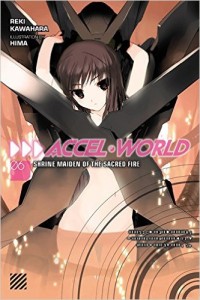By Reki Kawahara and Hima. Released in Japan by ASCII Mediaworks. Released in North America by Yen On.
One of Accel World’s strongest points is its ability to built on plot and themes from prior books without overwhelming the reader too much. The last book showed us that the Disaster Armor had not entirely left Silver Crow, and much of this volume is about the fallout from that. We worry about what such a thing would do to the game itself, and then later on find that crude copies of it may be racing out of control via other people, making the question moot. Or it would be moot if this wasn’t in may ways a desire for the others to punish Kuroyukihime through Haruyuki, as by now everyone can see their bond. We’re also asked to see one of the core tents of her past in a different light, as it’s hinted that there’s more to her killing off the Red King than just wanting to get to Level 10.
As for Haruyuki’s self-loathing, it’s gotten slightly better. We get a minimum of school here, and I was a bit faked out when we were introduced to two fellow classmates who I thought Haru would either bond with or get bullied by, but who ended up being mostly irrelevant, another way of showing that Haruyuki is not like the normal “cool” kids, who skive off their club work the first time we see them. Of course, this determination to get better and discover new things is what makes him such a success in the game world, as is pointed out by Chiyuri. One reason that Kuroyukihime, Fuko, and even Ash Roller like him to much is that he’s always seeking ways to get better, ways to play the game that are more than just “get strong and then stop”.
We also get a new character, the titular shrine maiden of the title. She’s around 9 years old, and half of the somewhat tossed off fanservice in the volume is dedicated to accidentally getting her wet with a garden hose (the other half being Kuroyukihime changing in front of Haru – and the cover, if we’re going to be honest). For once, though, it looks like the lolicon is not meant to be the primary driving force. Utai is interesting, from her game persona’s Sailor Mars-style powers, to the Incarnate she unleashed somehow being related to Noh Theater, or simply because she can’t speak – something prevents her from getting the words out, so she types all her dialogue in ways that would be very difficult if people in this universe didn’t already have neurolinkers. And, of course, by definition of the fact that she’s playing Brain burst, her home life is somewhat broken, though we get few details.
And, of course, there’s still the best reason to read Accel World: Kawahara writes excellent battle scenes. They’re understandable, easily visualized, and emotionally raw. They may also make you scream at the ending, as yes, this is a cliffhanger that will hopefully get resolved in the next book. It’s not as popular as Sword Art Online, but Kawahara’s other series quietly goes about telling its story well, and if you can get past Haru’s beating himself up narrations, well worth your time.

